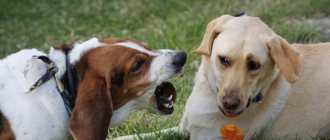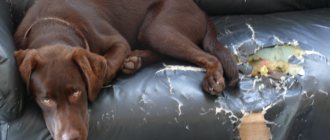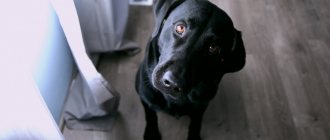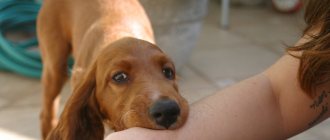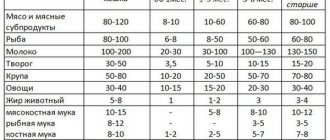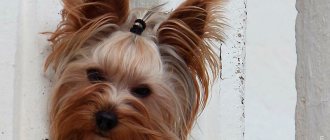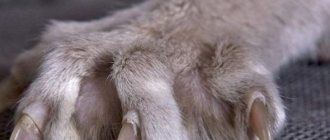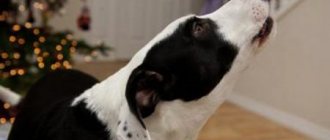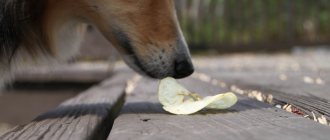Regardless of age, breed and size, the dog must be socialized. A well-mannered pet should not demonstrate hostility towards people and pets without reason - its aggressive reaction can cause harm to both the person against whom it is directed and him.
The dog attacks other dogs, what should I do?
Aggression - where does it come from?
In many cases, the animal's aggression lies on the side of the person who misinterpreted its behavior. The owner's most difficult task is to find the cause of the aggression. Therefore, you should look at everything more carefully: spend more time with your four-legged friend, change the environment often and even provoke certain situations and record the moment when your pet begins to get nervous.
The story of the English bulldog Johnny.
Here's a short story as told by the owners.
The owners purchased an English bulldog puppy at the request of their two sons. The head of the family made the decision to buy and the one and a half month old puppy appeared in the house, despite the protests of his wife, who foresaw many additional troubles.
The purpose of acquiring a dog was formulated by my eldest son Nikita, unexpectedly for me: “To unite the family.”
Four months ago, at the age of 1 year 6 months, Johnny was frightened by the roar of New Year's fireworks, after which he resolutely refused any walks and began to relieve himself in the apartment.
Disease
What are you talking about, we were friends!
A typical picture: a calm, balanced dog suddenly begins to attack its own kind. The owner is shocked, this has never happened, the pet has always treated his own kind favorably. An analysis of the situation begins, the owner tenses up and remembers: the pet began to attack other dogs after he got sick.
Yes, a sick dog is quite capable of showing aggression. This is explained by an attempt to protect themselves, because illness is a reason to be attacked or killed by their own relatives. For example, stray dogs that gather in packs do not stand on ceremony with sick “household members”; they are destroyed.
Estrus
Don't come near me, I'm offended!
Oh, many bitches become inadequate during heat. It seems that your pet is absolutely calm and balanced, but before and during heat you can turn off the lights. The pet becomes irritable, grumpy, and aggressive towards other dogs. This is especially true for male dogs who decide to meet a potential bride. Yes, and the bitches who decide to meddle with our heroine will not be happy.
The aggression will go away after the end of the heat. But it lasts 21-25 days, and even a couple of weeks before the onset, the dog begins to behave strangely. In general, the owner will have to muster up his patience for this period.
What to do if your pet attacks dogs on the street?
A dog’s aggression towards its relatives is usually explained by a low level of socialization or negative experiences that make the pet afraid of other four-legged animals.
Some pets behave more confidently if they are in their own territory or know that they are in the owner's field of view. Excessive aggression in generally calm dogs can be observed if the pet guards the territory entrusted to it, the owner, his things or his own bowl.
Regardless of the type of aggression shown, try to avoid punishing, humiliating, or intimidating your pet as much as possible. Naturally, if a dog shows aggression towards you, you (once and for all) must give a tough rebuff.
Types of aggression in dogs and methods for eliminating them
Not only the reasons and objects of attacks differ, but also the signs of hostility. Based on these criteria, 11 types of aggression are identified, eliminated by different methods.
Territorial
Often found in fighting and guard breeds due to their developed territorial and protective instincts. To adequately perceive the situation, such animals must be trained from puppyhood. Otherwise, they will attack not only real violators, but also:
- cats walking along the fence;
- neighbors who came to exchange a few words on your property;
- unexpectedly arriving friends;
- any people appearing outside the window.
If the aggressor calms down when he is not on his territory, learn security commands (“Voice”, “Guard”, “Stranger”). With their help, you will avoid empty barking at passing cars and teach you to protect entrusted items only with your permission. If you can’t cope on your own, sign up for ZKS courses.
Possessive
It manifests itself in a reluctance to give away toys or other objects that the dog considers his own. This is typical for animals that are accustomed to playing tug-of-war and do not perceive the authority of the owner.
Corrected through proper education. Stop attempts to assassinate the main role even in the game. Give out toys when you see fit, and be sure to stop playing if your pet starts growling at you. At such moments, the dog must be left alone, since ignoring is the most effective way of punishment.
Be sure to learn the “Fu” and “No” commands. They will help control the actions of your four-legged friend at home and on walks, eliminating unwanted guarding of toys or eating dangerous objects.
Dominant
Dominance manifests itself in ignoring commands, attacking a person and making independent decisions on any issues. The cause of dissatisfaction may be a ban on sleeping in the wrong place, combing the fur, pulling on the leash, staring, screaming or the use of physical force. Such actions are perceived as a demonstration of superiority, so a pet that disagrees with your authority will try to challenge the place of leader in its favor.
It is necessary to prove your leadership in your own home from the first days of the appearance of your four-legged friend. It is much easier to explain your superiority to a puppy, so try not to miss this moment. Set the desired prohibitions and never make concessions when they are violated. If your dog should not sleep in the same bed with you, do not allow him to do this even during illness.
Please note that the pet must unquestioningly follow the commands of all family members. Don't let him dominate the children, but don't physically punish them for disobedience either. This will only worsen the existing situation.
Discourage hand biting during play. This could result in some pretty serious injuries in the future. If you disobey, try to switch the aggressor’s attention by commanding “Sit” or “Lie down.”
Predatory
A developed hunting instinct forces one to pursue moving objects that suddenly appear in the field of view: running children, cyclists, cars, cats, rodents or birds. At such moments, the dog completely gives in to the chase, losing touch with the outside world. A four-legged pet keen on hunting can not only get lost, but also cause quite serious injuries to its target.
To prevent negative consequences, it is necessary to take your four-legged friend to special obedience courses. After this, unwanted actions can be stopped with the commands “Fu”, “Come to me” or “Lie down”, accompanied by a sharp pull on the leash.
Food
Food aggression in dogs is expressed by a warning growl at people or other pets trying to approach a bowl of food. Fearing for the safety of its “prey,” the animal may hastily swallow food or attack a competitor.
To solve the problem, it is necessary to change the feeding regimen, eliminating extraneous irritants. Feed your pet alone, do not let him bite and give treats only for real merit. Try the following exercise:
- Before serving food, give the command “Sit”.
- Then place the bowl and command “Wait”, not allowing you to touch the food until you receive the appropriate permission (“It’s OK”).
- After a while, interrupt the feeding by commanding “No” or “Wait.”
- Wait a few seconds and allow him to eat again.
If the exercise is successfully completed, praise your pet and give him a treat. If you fail, take the bowl and command “Place.” Repeat the previous steps regularly until the unwanted behavior disappears.
Protective
Characteristic of guard and service breeds that protect the thing or person entrusted to them. In the absence of a real threat, such a reaction is inadequate.
It is better to learn guard and protective service under the guidance of a dog handler. It is enough for the owner himself to prevent these actions with the help of timely socialization. Do not lock your dog alone in an enclosure and give him the opportunity to socialize with your friends and acquaintances to reduce existing anxiety. Encourage negative reactions to strangers only if they can really harm you.
Maternal
Protection of offspring is a natural reaction that occurs during bearing and feeding puppies. Most often it occurs in females, but sometimes it is also observed in males who protect the “nest” from the encroachment of potential enemies.
It is impossible to eliminate this type. It passes without outside help when the kids gain independence. It is enough for the owner to help secure the location of the “nest” and avoid provocations from the anxious mother.
Painful or fearful
Characteristic of insecure or abused animals. If your pet growls, bites his hands and hides in a corner during grooming or when he sees strangers, use sedatives and engage in socialization.
Ask your friends to come up to you on the street and give your dog a treat. Several such meetings will calm the four-legged aggressor and reduce existing anxiety. The treat can also be given after a haircut to create a pleasant association with the frightening procedure.
Separately, it is worth noting the pain caused by internal pathologies. If growling and grinning occur when trying to touch the belly, paws or other parts of the body, be sure to make an appointment with a veterinarian for diagnosis.
Intraspecific
It is most often observed between same-sex individuals shortly after puberty. The targets of attacks are weaker animals that are unable to stand up for themselves. The aggressor does not allow them to eat until the end of their own meal, takes away their toys, and does not allow them on the bed or in the room.
To suppress hostility, castration and sedatives will be required. Also, we must not forget about gradual socialization. Walk your rebel on a leash, stopping and punishing attempts to attack other animals.
During sexual heat
A surge in hormones is observed not only during pregnancy, but also during sexual intercourse. The female becomes aggressive shortly before ovulation and immediately after it ends. The male's aggressiveness lasts longer and is explained by the protection of the chosen one from possible competitors.
The most effective way to eliminate this species is castration. Thanks to the removal of the reproductive organs, the hormonal levels are stabilized, eliminating new outbursts of anger.
With breeding animals you will just have to wait out this stage. To protect others, be sure to put a muzzle and leash on your pet to prevent attacks and fights.
Unmotivated
The unmotivated appearance has no reason and occurs spontaneously due to mental deviation. A similar reaction is typical for individuals born as a result of violation of selection rules.
Such cases are rare and require the mandatory intervention of a veterinarian. It is impossible to correct the situation on your own.
Mental problems
Showdown
And this happens in our time. Even among purebred dogs purchased in mono-kennels from champion parents. Unfortunately, mental problems are especially common in long-haired “show class” German shepherds. At the sight of a fellow dog, the shepherd begins to “yell” at the top of his lungs, tries to rush at the other dog, his withers standing on end.
Attempts to distract and switch do not work. The dog continues the tantrum with an attempted attack until the potential enemy is behind or disappears from sight. Not only “German show dogs” are guilty of this behavior; other large, medium and small breeds do the same.
Zoo aggression
Very aggressive dog
Zoo aggression is a consequence of a mental problem in a dog. Some dogs just like to show off how “strong and independent” they are. This is not fear, but an attempt to show one’s own superiority over other dogs. As a rule, such attempts end in failure: if a large “strong and independent” dog attacks a smaller one, the latter will suffer the fate of a cripple, at a minimum. In the worst case scenario, a representative of a small breed will die.
Unfortunately, small dogs often behave aggressively towards large ones. The latter's owners, in most cases, are kept on leashes and can prevent an extraordinary situation from arising. And when a small dog runs and attacks a large pet, bursting into barking, trouble cannot be avoided.
The cause of zoo aggression, in addition to an attempt to demonstrate one’s own strength, can be fear. A dog, regardless of its breed, is simply afraid of its own kind. And the best defense, as we know, is attack. So the pet begins to actively attack other dogs, thus trying to prove its strength. But when the enemy tries to repel the attacker, the latter immediately loses his fighting spirit and cowardly retreats.
By the way, an attack out of fear looks completely different than when demonstrating one’s superiority. In the first case, the attacker begins to bark hysterically and wags his tail furiously. Some individuals also fold their ears back, pressing them to the head. In the second case, the attack can occur at lightning speed, the dog does not consider it necessary to warn about it by barking. He simply throws himself at a potential opponent and begins to roll him on the ground, strangling him or tearing him with his teeth.
Final commands and crowd behavior training
Once all the basic commands have been mastered, you can begin to learn more complex tricks.
Jumping over obstacles
You should start learning with not very high obstacles. Take the treat in your hand and lift it over the barrier. As soon as the puppy jumps over the obstacle, he needs to be praised and encouraged.
Walking in crowded places
The Jack Russell Terrier should only be walked on a leash. It is better to take your first walks in uncrowded places, far from busy roads. To socialize your pet, you can introduce it to other dogs. It is better to avoid contact with mongrels.
If your Jack Russell Terrier barks or lunges at other people, you need to yank him on the leash and say “No!”
Riding on public transport
To ride on public transport, your Jack Russell Terrier must be muzzled. You should enter the salon by saying “Nearby!” The terrier should be as close to the owner's feet as possible. Additionally, you can fix it by pulling the leash.
You should also exit the vehicle with the command “Near!”
Lack of obedience
I'm about to bite!
Please do not confuse education and obedience. Obedience is a section of dog training that involves knowledge and execution of primary commands, to put it very roughly. Such commands include “to me”, “next to me”, “sit, lie down, stand”, as well as a ban on certain actions.
The problem is that on the site with a canine handler, the pet is able to carry out commands, including prohibition, just perfectly. But on a walk, at the sight of another dog, the pet’s withers stand on end, and he goes to kill the enemy. The owner tries to prohibit the unwanted action, but the dog does not hear.
This indicates the owner's lack of authority. The owner simply failed to create contact with the dog, motivate it and teach it obedience.
Radical ways of education
You can resort to more radical methods of education. Use shocker collars, “strokers,” and ultrasonic devices that will help you form the right attitude towards your relatives, but only after prior consultation with a dog handler and veterinarian. Stronger stimuli will help to quickly instill in animals the correct behavioral skills and reflexes.
If the cause of aggression is stress, severe fear, or emotional overexcitation, you can give the dog sedatives. Consult your veterinarian regarding the choice of sedatives. Create the most comfortable environment possible, surround your pet with attention, affection and care.
To teach your beloved dog good manners and instill an adequate relationship with other animals, before choosing an educational method, determine the root cause of such behavior. Consider the age, individual, breed characteristics, temperament and type of nervous system of your pet. Always strive to achieve your goals and objectives, but never force your dog to do anything he cannot do.
How to stop a dog from lunging at others
— teach your pet basic commands
This is necessary so that you can switch it at the moment of attack or irritation
to something else (for example, to a ball, a stick, or even just to yourself). If it works, praise your dog and give him a treat. This way he will understand that when he listens to you, it is good. And gradually it will stop showing aggression towards other individuals.
- be patient
Use iron consistency and mental strength, thanks to which you can easily resist any antics of your beloved pet until he stops doing it. The dog looked at his opponent and growled? Quickly distract him and calmly lead him in the other direction. In a minute, he will completely forget that he just looked angrily or growled at someone.
Feeding the puppy
In order for a bulldog to grow into a large, healthy dog, the owner takes care of his diet from the first days. Factors taken into account:
- Representatives of the breed are prone to obesity.
- Bulldogs often develop allergies.
- “Frenchies” do not have the strongest teeth: they wear down quickly, so the dog is not given hard food or bones.
When switching from milk to independent nutrition, new products are introduced gradually, little by little, paying attention to possible allergic reactions. At first, bulldogs eat thick soups and thin porridges
Then little by little add boiled lean meat, fermented milk products, boiled and raw chopped vegetables. The contents of the diet are as follows:
- 35% carbohydrates: cereals, vegetables, fruits.
- 65% proteins: meat, fish, dairy, offal.
Up to a year, the daily intake of a puppy is approximately 8-10% of its own weight. Then the serving size is planned according to the dog’s individual parameters - height and weight. The feeding schedule changes with age:
- 1-2 months: 6 doses.
- 3 months: 5 doses.
- 5 months: 4 doses.
- 6 months: 3 doses.
- From 8 months: no more than 2 doses.
Teenagers and adult dogs are given more raw meat and offal. The best option is lean veal, scalded with boiling water or boiled for 10 minutes. It is cut into small pieces - minced meat is not suitable (it will lead to degradation of the chewing function). Acceptable norm: 20-30 g of meat per 1 kg of dog weight.
An adult “Frenchman” also needs the following:
- rabbit, lamb, horse meat;
- tripe, liver;
- rice, barley, buckwheat, oatmeal;
- fermented milk products (especially calcined cottage cheese);
- “cat grass”, dandelions, parsley, sprouted cereals;
- carrots, zucchini, bell pepper, pumpkin;
- low-fat sea and ocean fish (seedless);
- fresh fruits;
- eggs (at least 2 times a week).
